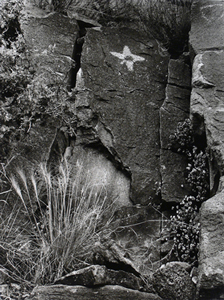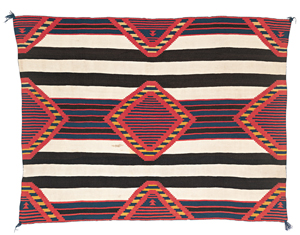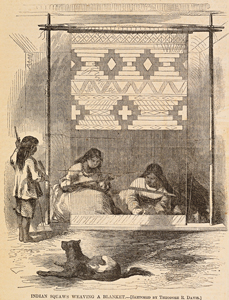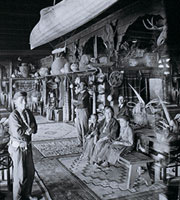 The history of art in New Mexico begins with the earliest inhabitants, the Paleo-Indians, who developed their arts over thousands of years, and left artifacts buried in ruins and mysterious images drawn on canyon walls. Eventually Native Americans, first the Pueblo culture, followed by the Apache and Navajo, settled permanently in New Mexico. These early artists created designs and images based on strong spiritual connections to the surrounding natural world.
The history of art in New Mexico begins with the earliest inhabitants, the Paleo-Indians, who developed their arts over thousands of years, and left artifacts buried in ruins and mysterious images drawn on canyon walls. Eventually Native Americans, first the Pueblo culture, followed by the Apache and Navajo, settled permanently in New Mexico. These early artists created designs and images based on strong spiritual connections to the surrounding natural world.
 In the 1500s, the Spanish culture arrived and brought new ideas, including Christian iconography, and materials to the region such as metal, wool, paints and dyes. In the 1800s, the first European-American tourists began to visit via trail and train. The artists who followed were inspired by the region’s cultures and landscape, and they in turn brought new ideas and trends from their art world to the region. The artwork that has been produced in New Mexico since this time has been influenced by these the indigenous, Spanish and Anglo traditions and by the unique qualities of the region’s communities and natural environment.
In the 1500s, the Spanish culture arrived and brought new ideas, including Christian iconography, and materials to the region such as metal, wool, paints and dyes. In the 1800s, the first European-American tourists began to visit via trail and train. The artists who followed were inspired by the region’s cultures and landscape, and they in turn brought new ideas and trends from their art world to the region. The artwork that has been produced in New Mexico since this time has been influenced by these the indigenous, Spanish and Anglo traditions and by the unique qualities of the region’s communities and natural environment.
 When the transcontinental train reached the territory of New Mexico in 1879, a “culture rush” began, and European-American artists and anthropologists hurried to the region to collect artworks and document native lifestyles before everything was changed by the influx of outsiders. The drawings, photographs and paintings that artists made at this time were often used to advertise the exotic Southwestern landscape, and the native people who lived here.
When the transcontinental train reached the territory of New Mexico in 1879, a “culture rush” began, and European-American artists and anthropologists hurried to the region to collect artworks and document native lifestyles before everything was changed by the influx of outsiders. The drawings, photographs and paintings that artists made at this time were often used to advertise the exotic Southwestern landscape, and the native people who lived here.
 The first images of Native American cultures in New Mexico were made by artists, writers and photographers who were paid by journals such as Harper’s Weekly and Scribners. Illustrated articles about the Zuni tribe by Frank Hamilton Cushing and the Hispanic Penitente Brothers by Charles Fletcher Lummis are examples of popular articles from this time. Lummis went on to write many more articles about the peoples of the Southwest, and he helped create a mystique about the picturesque Southwestern cultures and land.
The first images of Native American cultures in New Mexico were made by artists, writers and photographers who were paid by journals such as Harper’s Weekly and Scribners. Illustrated articles about the Zuni tribe by Frank Hamilton Cushing and the Hispanic Penitente Brothers by Charles Fletcher Lummis are examples of popular articles from this time. Lummis went on to write many more articles about the peoples of the Southwest, and he helped create a mystique about the picturesque Southwestern cultures and land.
 Photographers capitalized on this mystique and made postcards and calendars of Native Americans that created stereotypical images of the people who lived here. In 1902, the Fred Harvey Company built the Alvarado Hotel at the railroad station in Albuquerque. Part of the hotel was designated “The Indian Building” as a place where Native American artists sold their wares to tourists. This enterprise was successful, and the artists began to change their styles depending on what sold. Consequently the artwork became less authentic and more commercial. In time, prominent artists and anthropologists would try to fight the commercialization of indigenous arts, and influence the quality of work that was created.
Photographers capitalized on this mystique and made postcards and calendars of Native Americans that created stereotypical images of the people who lived here. In 1902, the Fred Harvey Company built the Alvarado Hotel at the railroad station in Albuquerque. Part of the hotel was designated “The Indian Building” as a place where Native American artists sold their wares to tourists. This enterprise was successful, and the artists began to change their styles depending on what sold. Consequently the artwork became less authentic and more commercial. In time, prominent artists and anthropologists would try to fight the commercialization of indigenous arts, and influence the quality of work that was created.
